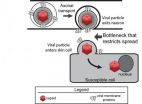(Press-News.org) This press release is available in Spanish.
A tip about a folk remedy plant used in India and Africa to ward off bugs has led to the discovery of insect-repelling compounds.
U.S. Department of Agriculture (USDA) scientists have identified components of Jatropha curcas seed oil that are responsible for mosquito repellency. Researchers at the Agricultural Research Service (ARS) Natural Products Utilization Research Unit (NPURU) in Oxford, Miss., often find effective plant-derived compounds to deter insects by gathering plants in the wild and investigating those used in traditional folk remedies. ARS is USDA's principal intramural scientific research agency.
After learning that people in India burn J. curcas seed oil in lamps to keep insects out of their homes and other areas, NPURU chemist Charles Cantrell extracted smoke from the plant in a laboratory and analyzed its properties. Free fatty acids and triglycerides were among a number of active compounds found to be effective at preventing mosquitoes from biting.
Researchers have known for some time that fatty acids repel insects, but this was the first known report that identified triglycerides as having mosquito repellent activity, according to Cantrell.
Working closely with colleagues at ARS and the National Center for Natural Products Research at the University of Mississippi, Cantrell is exploring additional promising compounds from other plants. By combining these or similar compounds from other plants with those in Jatropha species, scientists might be able to develop a more effective product.
### Read more about this other research to protect U.S. troops from harmful insects in the November/December 2012 issue of Agricultural Research magazine.
http://www.ars.usda.gov/is/AR/archive/nov12/insects1112.htm
USDA is an equal opportunity provider and employer. To file a complaint of discrimination, write: USDA, Office of the Assistant Secretary for Civil Rights, Office of Adjudication, 1400 Independence Ave., SW, Washington, DC 20250-9410 or call (866) 632-9992 (Toll-free Customer Service), (800) 877-8339 (Local or Federal relay), (866) 377-8642 (Relay voice users).
Scientists identify insect-repelling compounds in Jatropha
2012-11-05
ELSE PRESS RELEASES FROM THIS DATE:
Loser-pays-all rule in criminal cases could work for wealthy defendants
2012-11-05
CHAMPAIGN, Ill. — Adopting a loser-pays-all rule for criminal litigation would likely be feasible only if the rule applied to defendants who are wealthy, says a study from a University of Illinois law professor.
Nuno Garoupa, the H. Ross and Helen Workman Research Scholar in the College of Law, says a loser-pays-all rule could deter some crime when it's applied to either a corporation or an individual with deep pockets. But when defendants are not wealthy, such cost-shifting would be "wholly inappropriate," he says.
"On the defendant's side, the problem is that a significant ...
Checklists in the operating room: More safety for patients
2012-11-05
The use of the World Health Organization's Surgical Safety Checklist in the operating room considerably lowers the risks of surgery. This is the conclusion of Axel Fudickar and co-authors in their article in Issue 42 of Deutsches Ärzteblatt International (Dtsch Arztebl Int 2012; 109(42): 695).
The most common errors in safety-related behavior in the operating room are attributable to inadequate communication and teamwork. The Surgical Safety Checklist, which was introduced by the World Health Organization in 2007, has the main effect of improving commmunication of the ...
2001-2002 drought helped propel mountain pine beetle epidemic, says CU study
2012-11-05
A new University of Colorado Boulder study shows for the first time that episodes of reduced precipitation in the southern Rocky Mountains, especially during the 2001-02 drought, greatly accelerated development of the mountain pine beetle epidemic.
The study, the first ever to chart the evolution of the current pine beetle epidemic in the southern Rocky Mountains, compared patterns of beetle outbreak in the two primary host species, the ponderosa pine and lodgepole pine, said CU-Boulder doctoral student Teresa Chapman. The current mountain pine beetle outbreak in the ...
Spinal cord injury puts patients at high risk of life-threatening cardiovascular events
2012-11-05
New Rochelle, NY, November 5, 2012—Spinal cord injury (SCI) can disrupt the body's sensitive signaling mechanisms that control blood pressure, breathing, and oxygen delivery to the heart and other organs during changes in body position. Cardiovascular (CV) disease is a leading cause of illness and death following SCI, and changes in baroreflex sensitivity—the body's ability to detect and respond to changes in blood pressure—may be predictive of a CV event. A comprehensive review article on baroreflex sensitivity after SCI is published in Journal of Neurotrauma, a peer-reviewed ...
Etiologic diagnosis of nonsyndromic genetic hearing loss in adult vs pediatric populations
2012-11-05
Alexandria, VA — Genetic testing for a certain mutation in pediatric patients is valuable in determining a cause for unexplained hearing loss, according to a study in the November 2012 issue of Otolaryngology–Head and Neck Surgery.
The study's authors state that testing for some of the most common mutations that cause sensorineural hearing loss in a targeted way, rather than through generalized screening of hearing loss patients, yields the best results.
University of Miami NIH-funded researchers led by Dr. Xue Zhong Liu, a physician-scientist, conducted a nine-year ...
The knowing nose: Chemosignals communicate human emotions
2012-11-05
Many animal species transmit information via chemical signals, but the extent to which these chemosignals play a role in human communication is unclear. In a new study published in Psychological Science, a journal of the Association for Psychological Science, researcher Gün Semin and colleagues from Utrecht University in the Netherlands investigate whether we humans might actually be able to communicate our emotional states to each other through chemical signals.
Existing research suggests that emotional expressions are multi-taskers, serving more than one function. Fear ...
Study supports move toward common math standards
2012-11-05
EAST LANSING, Mich. — A new study analyzing the previous math standards of each state provides strong support for adoption of common standards, which U.S. students desperately need to keep pace with their counterparts around the globe, a Michigan State University scholar argues.
Forty-six states are implementing the Common Core math and reading standards, which nonetheless have come under fire recently by some researchers and would-be politicians.
But William Schmidt, MSU Distinguished Professor of statistics and education, said the Common Core is a world-class set ...
Waste management -- good marketing
2012-11-05
This press release is available in Spanish.
Spanish legislation on waste management changed in July last year. Until then, the consumer was responsible for the disposal of products. According to Mr Unai Tamayo, economist at the University of the Basque Country (UPV/EHU), the new laws "foment the construction of closed systems, such as in taverns: the container being taken out and subsequently returned. Moreover, when a manufacturer launches a product on to the market, once consumed, the packaging is considered waste, and the responsibility for this now falls on the manufacturer ...
Princeton researchers identify unexpected bottleneck in the spread of herpes simplex virus
2012-11-05
VIDEO:
Princeton University research suggests that a common strain of herpes virus causes cold sores with only one or two viral particles, resulting in a bottleneck in which the infection is...
Click here for more information.
New research suggests that just one or two individual herpes virus particles attack a skin cell in the first stage of an outbreak, resulting in a bottleneck in which the infection may be vulnerable to medical treatment.
Unlike most viruses that ...
New research suggests standardized booster seat laws could save lives of children
2012-11-05
Boston, Mass, Nov. 5, 2012— A new study by researchers in Boston Children's Hospital's Division of Emergency Medicine indicates that a nationwide standard on booster seat laws for children 4 feet 9 inches and shorter, or up to 8 years old, would save lives. The findings were published online Nov. 5, 2012, in the journal Pediatrics.
Boston Children's researchers reviewed data from Fatality Analytic Reporting System, analyzing child deaths in motor vehicle accidents, looking specifically at whether the crash and resulting deaths or injuries took place in a state with or ...




